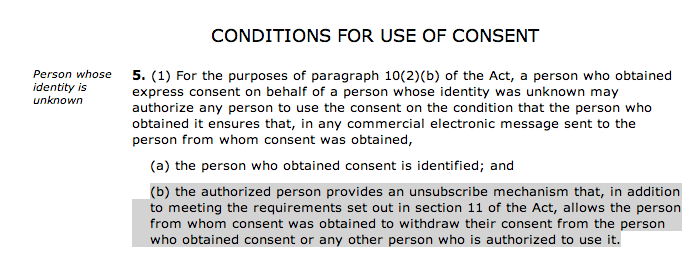This morning, I received an email from Toronto-based PR agency Paradigm PR about a new partnership between NBA Canada and Foot Locker Canada.
I’m guessing the agency’s client is NBA Canada, since they offered an interview with Dan MacKenzie (although the email spelled it MacKenize), VP and General Manager of NBA Canada, to discuss the partnership.
Unfortunately, what stood out for me was not the chat opportunity, but the complete lack of any kind of Unsubscribe option at the end of the email. Below is a screen grab from the email close (I’ve blurred out the sender’s name).
As you can see, there are plenty of ways to contact the company, but there’s nothing there about removing yourself from their updates. And that breaks the law (or is about to).
It’s Not Just CAN-SPAM Anymore
Recently, I wrote about companies that circumnavigate the CAN-SPAM Act, which was brought into play 10 years ago to protect consumers from spammy emails via questionable marketing tactics.
However, this act was primarily for the U.S. (although other countries could adopt it, if they wished). So, in Canada, where I live, you could still receive emails from companies without realizing you’re on their contact list.
I don’t recall ever signing up for Paradigm PR emails in particular. However, it may be I’m on a PR list for Canadian bloggers, hence the contact (although these lists are equally annoying, but that’s a blog post for another time).
So, because Canada isn’t technically covered by the CAN-SPAM Act, if you do get on a PR agency’s blogger list you have to hope they offer an Unsubscribe option. Otherwise, it’s a matter of requesting they remove you, or simply hitting the “Spam” button on your email filter.
If a company email gets filtered this way enough times by enough different recipients, their email address gets flagged by web hosts, and you can imagine the grief that causes for a business whose bread and butter is in promotional outreach…
Thankfully, that’s all about to change, with the introduction of Canada’s Anti Spam Legislation (CASL).
CASL and What It Means for Agencies and Marketers
Coming into effect July 1 2014, the new Canada Anti Spam Legislation aims to do for Canadians what CAN-SPAM has attempted to do for Americans – protect consumers while still allowing businesses to be competitive in an ever-changing marketing landscape.
While the full legislation breaks down exactly what will and will not be allowed, the two key points that all agencies and marketers will need to adhere to are:
- sending of commercial electronic messages without the recipient’s consent (permission), including messages to email addresses and social networking accounts, and text messages sent to a cell phone;
- (b) the authorized person provides an unsubscribe mechanism that, in addition to meeting the requirements set out in section 11 of the Act, allows the person from whom consent was obtained to withdraw their consent from the person who obtained consent or any other person who is authorized to use it.
It’s this second point in particular that would make the email I received from Paradigm PR illegal, and punishable not only by three Canadian organizations – the CRTC, the Competition Bureau and the Office of the Privacy Commissioner – but also opens up the potential for consumers to sue businesses that send out emails without an Unsubscribe option.
The involvement of the Office of the Privacy Commissioner is especially welcome for consumers, given their office forced Facebook to change its privacy settings for Canadian users, amongst other victories for Canadian consumers against social networks and data tracking.
Make Sure Your Agency is Ready
In one respect, it’s kind of disappointing to still be talking about best practices as well as legal requirements when it comes to email marketing (or any kind of digital marketing, since this impacts social network messages as well as mobile marketing).
It’s been more than almost 15 years since Seth Godin popularized Permission Marketing, about the need for opt-in marketing versus opt-out marketing. Yet here we are, still seeing emails being sent out without Unsubscribes, and lists being utilized without a blogger’s knowledge (if that’s the case with this example).
While the CAN-SPAM Act is U.S.-centric, it’s generally seen as a best practice to adopt by marketers and agencies in other countries. Thanks to the imminent CASL, it will no longer be enough to just follow best practices in Canada.
The mandate and requirements are there for every agency owner and marketer to read and understand.
With a full six months before legal enforcement, now would be a good time to become familiar with them – before it’s more than just a blog post that your agency’s lack of Unsubscribe option has as a result of your outreach.
Update December 16, 2013: I chatted with the account director who sent the email earlier, and the outreach was part of a personal outreach tactic for certain bloggers. The AD wasn’t aware of the unsubscribe requirement, which suggests a larger issue of education regarding email and/or digital outreach campaigns.





